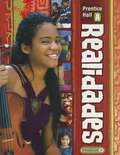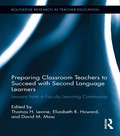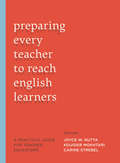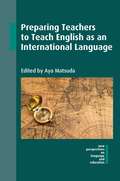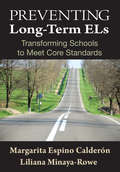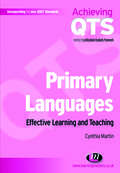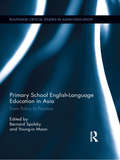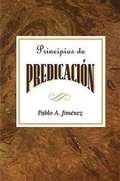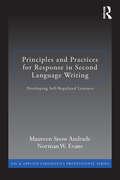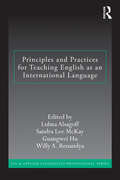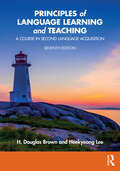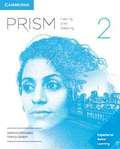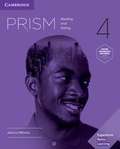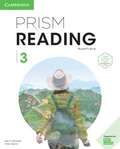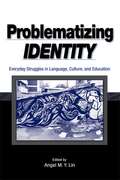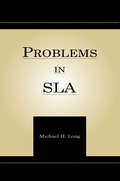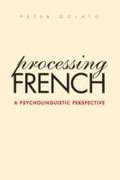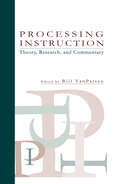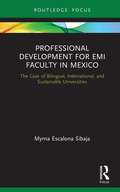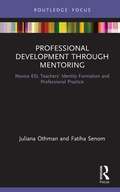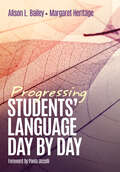- Table View
- List View
Prentice Hall Realidades, 3
by Peggy Palo Boyles Myriam Met Richard S. SayersNIMAC-sourced textbook
Prentice Hall Realidades, A
by Peggy Palo Boyles Myriam Met Richard S. SayersNIMAC-sourced textbook
Preparing Classroom Teachers to Succeed with Second Language Learners: Lessons from a Faculty Learning Community (Routledge Research in Teacher Education)
by Thomas H. Levine Elizabeth R. Howard David M. MossThis volume identifies resources, models, and specific practices for improving teacher preparation for work with second language learners. It shows how faculty positioned themselves to learn from resources, experts, preservice teachers, their own practice, and each other. The teacher education professionals leverage their experience to offer theoretical and practical insights regarding how other faculty could develop their own knowledge, improve their courses, and understand their influence on the preservice teachers they serve. The book addresses challenges others are likely to experience while improving teacher preparation, including preservice teacher resistance, the challenge of adding to already-packed courses, the difficulty of recruiting and retaining busy faculty members, and the question of how to best frame the larger issues. The authors also address options for integrating the work of improving teacher preparation for linguistic diversity into a variety of different teacher education program designs. Finally, the book demonstrates a data-driven approach that makes this work consistent with many institutions’ mandate to produce research and to collect evidence supporting accreditation.
Preparing Every Teacher to Reach English Learners: A Practical Guide for Teacher Educators
by Joyce W. Nutta Kouider Mokhtari Carine Strebel2013 Outstanding Book Award, American Association of Colleges for Teacher Education (AACTE)Preparing Every Teacher to Reach English Learners presents a practical, flexible model for infusing English learner (EL) instruction into teacher education courses. The editors outline the key steps involved in this approach—winning faculty support, assessing needs, and developing capacity—and share strategies for avoiding pitfalls. The central chapters feature sample courses illustrating how EL content can be incorporated into standard courses (human development, learning disabilities, and social foundations) and across subject areas and topics (math, science, social science, physical education, and classroom management). Most preservice teacher candidates report that they feel unprepared to work with English learners. This practical, flexible model for infusing EL content into teacher education will provide an invaluable resource in shaping the next generation of teachers.
Preparing Teachers to Teach English as an International Language
by Aya MatsudaThis book explores ways to prepare teachers to teach English as an International Language (EIL) and provides theoretically-grounded models for EIL-informed teacher education. The volume includes two chapters that present a theoretical approach and principles in EIL teacher education, followed by a collection of descriptions of field-tested teacher education programs, courses, units in a course, and activities from diverse geographical and institutional contexts, which together demonstrate a variety of possible approaches to preparing teachers to teach EIL. The book helps create a space for the exploration of EIL teacher education that cuts across English as a Lingua Franca, World Englishes and other relevant scholarly communities.
Prepositions (Barron's ESL Proficiency)
by Jean Yates Ph.D.Barron&’s ESL Proficiency Series: Prepositions provides comprehensive coverage of this most difficult topic in English grammar. The idiosyncratic nature of prepositions often makes them a barrier to achieving English language proficiency. Jean Yates offers clear explanations with lots of examples and opportunities to practice. Content is organized into simple 15-minute units each of which has its own practice exercises. An answer key is included in the back of the book. The ESL Profiency Series is a valuable tool for ESL teachers, tutors and learners who want to advance their English language skills for work, school or to prepare for proficiency tests such as TOEFL, IELTS, or TOEIC. It is ideal for independent study.
Preventing Long-Term ELs: Transforming Schools to Meet Core Standards
by Margarita Espino Calderon Dr Liliana Minaya-Rowe10 keys to keeping English learners from falling through the cracks Students who struggle with English are likely to struggle with academic content throughout their school years. Many drop out. This practical guidebook’s 10 components for success will help educators at all levels close this achievement gap. Included are step-by-step instructions for integrating language, literacy, and subject matter to improve student learning. Key features include: A clearly articulated, evidence-based professional development program for effectively teaching English language learners Research-based coaching practices for improving instruction Ways to implement the program while concurrently meeting core standards and content objectives
Primary Languages: Effective Learning And Teaching (Achieving QTS Series)
by Cynthia MartinPrimary languages are to be an entitlement for all pupils in KS2 from 2010. There is therefore a need to ensure that trainee primary teachers are equipped with the required skills, knowledge and understanding to contribute to this process. This book supports specialists, and also non-specialist trainees with an interest in MFL, who may need to deliver languages across the curriculum, providing them with a clear understanding of the methodology and helping them to develop linguistic competence and confidence.
Primary School English-Language Education in Asia: From Policy to Practice (Routledge Critical Studies in Asian Education #1)
by Bernard Spolsky Young-In MoonIn Asia, English is no longer a foreign language but a key resource for education, government, business and the general public. Whereas thirty years ago, British and American experts believed that the best way to improve the quality of English teaching was to cancel any programs below the secondary level, Asian nations as well as European are now introducing English in primary school. But there are major obstacles to overcome: the training of enough local teachers or the hiring of English speakers, the preparation of suitable teaching materials, the development of useful tests, and the design of workable curriculums. The chapters in this book, written by leading English-teaching professionals in seven Asian countries and originally delivered at the 2010 annual conference of Asia TEFL which took place in Hanoi, Vietnam, describe and analyze national policies and how they are implemented. The coverage is wide: China with its huge number of students learning English, Japan working to make the transition from elementary to secondary school seamless, Singapore continuing to use English as medium of instruction for its multilingual population, Korea developing English education policies to recognize the increased role of English alongside the national language, India building on its colonial past to make English an economic resource, Vietnam fitting English into a program of national rebuilding, and Taiwan spreading its English teaching outside the national capital. This is not a report of the views of outside experts, but of local experiences understood by local scholars of international standing. Policy makers, educators, researchers and scholars will be able to gain valuable insights from Asian experts.
Principios de predicación AETH: Principles of Preaching Spanish
by Abingdon Press Pablo A. JimenezSe requiere una habilidad poco usual en el manejo del idioma literario para combinar profundidad y sencillez para definir términos profesionales en lenguaje laico y a la vez hacer un libro de texto y manual de inspiración. Pablo Jiménez tiene esa capacidad. Su tratado sobre la predicación esta redactado en lenguaje sencillo y ampliamente ilustrado. Es suficientemente ameno como para servir de material suplementario o de inspiración a quienes solo quieren disfrutar un poco de buena lectura y de la cual sacar ideas para su uso personal. Sin embargo a la vez esta obra es suficientemente profunda como para convertirse en libro de texto para institutos teológicos, colegios o seminarios.
Principles and Practices for Response in Second Language Writing: Developing Self-Regulated Learners (ESL & Applied Linguistics Professional Series)
by Maureen Snow Andrade Norman W. EvansBased on the assumptions that students expect feedback and want to improve, and that improvement is possible, this book introduces a framework that applies the theory of self-regulated learning to guide second language writing teachers’ response to learners at all stages of the writing process. This approach provides teachers with principles and activities for helping students to take more responsibility for their own learning. By using self-regulated learning strategies, students can increase their independence from the teacher, improve their writing skills, and continue to make progress once the course ends, with or without teacher guidance. The book focuses on the six dimensions of self-regulated learning —motive, methods of learning, time, physical environment, social environment, and performance. Each chapter offers practical activities and suggestions for implementing the principles and guidelines, including tools and materials that teachers can immediately use.
Principles and Practices for Teaching English as an International Language (ESL & Applied Linguistics Professional Series)
by Lubna Alsagoff Willy A. Renandya Guangwei Hu Sandra Lee McKayWhat general principles should inform a socioculturally sensitive pedagogy for teaching English as an International Language and what practices would be consistent with these principles? This text explores the pedagogical implications of the continuing spread of English and its role as an international language, highlighting the importance of socially sensitive pedagogy in contexts outside inner circle English-speaking countries. It provides comprehensive coverage of topics traditionally included in second language methodology courses (such as the teaching of oral skills and grammar), as well as newer fields (such as corpora in language teaching and multimodality); features balanced treatment of theory and practice; and encourages teachers to apply the pedagogical practices to their own classrooms and to reflect on the effects of such practices. Designed for pre-service and in-service teachers of English around the world, Principles and Practices for Teaching English as an International Language fills a critical need in the field.
Principles of Language Learning and Teaching: A Course in Second Language Acquisition
by H. Douglas Brown Heekyeong LeeThe seventh edition of this classic second language acquisition (SLA) text provides an overview of the theoretical foundations of language teaching. This new edition has been updated to capture current research and practice in the field. Among concepts that are either redefined or entirely new are: Language learning in an era of globalization and multilingualism The significance of transnationalism, identity, investment, agency, and ideology Language learning as situated, usage-based, and socioculturally contextualized The importance of emotional engagement, intercultural sensitivity, and self-efficacy in language learning Transdisciplinary and ecological approaches as keys to language teaching in the 21st century The seventh edition also retains useful historical information and foundational cornerstones of SLA that teachers have found beneficial in their instruction. Key principles continue to be presented and explained with direct application to classroom language education and real-life contexts. Features such as "Points to Ponder" (questions for readers’ personal reflection), classroom connections and "Tips for Teaching," suggested readings, and a glossary of terminology are updated in this edition. With its reader-friendly style, practical pedagogical tools, and comprehensive coverage of state-of-the-art research findings, this edition serves as an essential resource for language teacher education programs worldwide, catering to the needs of both novice and experienced language teachers.
Prism Level 2: Listening and Speaking
by Angela Blackwell Sabina Ostrowska Nancy Jordan Janet GokayPaired skills course focusing on critical thinking, academic skills, and language students need most. Prism is a five-level (A1 to C1), American English paired-skills course (Reading/Writing and Listening/Speaking), created for students who need to develop a range of academic skills. This Level 2 (B1) Listening and Speaking Student's Book prepares students for college classes by developing their listening, speaking, critical thinking, and pronunciation skills, including pronunciation for listening. Special sections teach how to be a successful college student, and the accompanying video program sets the stage for each unit's topic. Inside the book is a single-use code for the online workbook. This provides automatically graded extra practice and works on PCs and Macs.
Prism Level 4 Student's Book With Online Workbook Reading And Writing (Prism)
by Jessica Williams Wendy Asplin Christina CavagePaired skills course focusing on critical thinking, academic skills, and language students need most. Prism is a five-level (A1 to C1), American English paired-skills course (Reading/Writing and Listening/Speaking), created for students who need to develop a range of academic skills. This Level 4 (C1) Reading and Writing Student’s Book prepares students for college classes by developing their critical thinking, reading and writing skills, including grammar for writing. Special sections teach how to be a successful college student, and the accompanying video
Prism Reading Level 3 Student's Book With Online Workbook
by Alan S. Kennedy Chris SowtonPrism Reading Level 3 has 8 units to develop vocabulary, academic, and critical thinking skills. Students experience topics through fascinating readings in a wide variety of genres and formats to become familiar with material they might face in or outside the college classroom. Each book includes a single-use code to access the Online Workbook that has one new reading per unit, extra practice to further improve reading, vocabulary, and language development. Other resources include videos and recordings of readings. Activities have automated feedback to help with learner autonomy, and for teachers to spend less time grading and more time teaching.
Prism: Level 1 Student's Book With Online Workbook Reading And Writing (Prism)
by Wendy Asplin Carolyn Flores Richard O'Neill Michele LewisPrism Level 1 Student's Book Reading and Writing 9
Problematizing Identity: Everyday Struggles in Language, Culture, and Education
by Angel M. Y. LinThis book argues that identity as a term needs to be problematized, not taken for granted � for both the risks and the potential that the concept offers to educators for understanding issues of social inequality and how social inequality is being reproduced, and for exploring possible alternative ways educators can work with identity de/formation p
Problems in Second Language Acquisition (Second Language Acquisition Research Series)
by Michael H. LongSecond language acquisition has an identity problem. It is a young field struggling to emerge from the parent fields of education and applied linguistics. In his new book, Problems in Second Language Acquisition, Mike Long proposes a way to help second language acquisition develop a systematic and coherent focus using the philosophy of science as the lens.The volume is neatly organized into three parts--theory, research, and practice. This structure allows a focus on areas of SLA of interest to many in the field. These include theory proliferation and comparative theory evaluation; the Critical Period Hypothesis and negative feedback; and the practice of “synthetic” language teaching.The controversial volume will be of interest to researchers, educators, and graduate students in second language acquisition, applied linguistics, TESOL, and linguistics programs. It may be recommended as additional reading for an introductory SLA course in order to stimulate class discussions.
Processing French: A Psycholinguistic Perspective
by Peter GolatoProcessing French presents a groundbreaking empirical study of the processing of morphologically simple and complex French words. Peter Golato's research offers an insightful account of the lexical storage and retrieval of isolated words and words within sentences. Processing Frenchinvestigates the native-language processing of French, a language for which findings have not definitively supported a dual-mechanism account of morphological processing. Through word- and sentence-level studies, the book accomplishes two goals. First, it offers behavioral evidence in support of a dual-mechanism processing account at the word level. In contrast to English, however, the evidence with French does not turn upon a contrast in inflectional regularity among verbs but instead hinges upon a diachronic contrast, with synchronic relevance, in the productivity of derivational suffixes among nouns. Second, by incorporating the findings of the word-level studies into sentence-level studies, the book offers a window onto the morphological processing of displaced sentential elements, specifically morphologically simple and complex-moved nouns and raised lexical verbs. Peter Golato is assistant professor of French at the University of Illinois at Urbana-Champaign. "Processing French is decidedly original, and it is equally and decidedly sound. This book makes a superb shelf reference for anybody working in psycholinguistics, first- and second-language acquisition, and the syntactic study of French. . . and draws some fascinating conclusions about what might really be at play in human language acquisition. " -Fred Davidson, University of Illinois at Urbana-Champaign
Processing Instruction: Theory, Research, and Commentary (Second Language Acquisition Research Series)
by Bill VanPattenThis new book, Processing Instruction: Theory, Research, and Commentary, edited by Bill VanPatten--a pioneer in processing instruction (PI)--is a refreshing presentation of 10 related and not widely available articles that illustrate the role of processing instruction in second language acquisition. The articles provide both historical and current context, as well as describe the influence of the input processing model on PI. The contents include empirical papers presenting new data that demonstrate both the theoretical and pedagogical threads of research. Aside from simply establishing where PI stands in the field of instructed SLA, the book addresses issues, such as processing instruction versus other types of instruction; the impact of processing instruction on various linguistic structures; the role of explicit information in instructional intervention; and the long-term effects of processing instruction. Each section of the book is highlighted by commentaries from noted researchers in instructed SLA. An attempt was made to include voices that offer critical perspectives on various issues of PI research. The book achieves an unusually balanced approach to a subject that has stirred debate in the field. Processing Instruction: Theory, Research, and Commentary will serve as an important source of information regarding research methodology and replication in second language acquisition. It will also be useful in graduate courses where students need exposure to research design and is especially useful for illustrating the usefulness of replication in SLA research.
Professional Development for EMI Faculty in Mexico: The Case of Bilingual, International, and Sustainable Universities (Routledge Focus on English Medium Instruction in Higher Education)
by Myrna Escalona SibajaDespite Mexico’s implementation of a bilingual model in its tertiary education programmes, this book is the first contribution to knowledge regarding EMI in Mexico. The author introduces readers to the Mexican higher education context before providing detailed information regarding the technological and polytechnic subsystem, where EMI has been implemented since 2012. The volume details a pilot and case study conducted in Mexican universities as well as the research findings and conclusions. It closes with recommendations, as well as suggestions for further research. The book explores the implications for the continuous professional development and training for lecturers in the current shift to EMI in Bilingual, International, and Sustainable (BIS) universities. This volume will be of particular interest to researchers in EMI and bilingualism.
Professional Development through Mentoring: Novice ESL Teachers' Identity Formation and Professional Practice (Routledge Research in Teacher Education)
by Juliana Othman Fatiha SenomIn their book, Othman and Senom provide a unique insight into the challenges faced by novice English as a Second Language (ESL) teachers and establish how mentoring can provide effective support for new teachers’ professional development. The book demonstrates the theoretical background for viewing mentoring as a process crucial to novice teachers’ development, particularly to the teachers’ ability to succeed and grow in a specific workplace environment. Using case studies from a Malaysian context, this book provides a comprehensive understanding of how mentoring can serve as a strategy to facilitate the transition of novice ESL teachers from a teacher education programme to life in real classrooms. Through its case studies, the book will examine both theoretical and practical issues for mentors, teacher educators, policymakers, and administrators when mentoring new ESL teachers. This book will be valuable to researchers who are particularly interested in exploring novice teachers’ identity development, and experienced teachers to help guide new teachers through the socialization process in their schools.
Progressing Students′ Language Day by Day
by Margaret Heritage Alison L. BaileyBecause content and language learning go hand in hand New content standards integrate content and language in ways prior standards have never done. That’s why it’s so critically important that teachers attend to both content and language development when introducing new subject matter, especially for English learners. Here’s your opportunity to get started tomorrow and every day thereafter: Alison Bailey and Margaret Heritage’s all-new Progressing Students’ Language Day by Day. What’s so utterly ground-breaking about this book is Bailey and Heritage’s Dynamic Language Learning Progression (DLLP) process: research-based tools for obtaining much deeper insight into a student’s language progress, then for identifying the most appropriate instructional steps to elevate language proficiency and content knowledge. Step by step, Bailey and Heritage describe how to Engage with students to advance their development of sophisticated, high-leverage language features for explaining content Use the DLLP approach to formative assessment, then plan your teaching in response to assessment evidence Examine words, sentences, and discourse --the three dimensions of language that are part of the DLLP process for cultivating language development Discover how leadership support and communities of practice (CoPs) can facilitate a successful and sustainable implementation of the DLLP process Listen more closely and uncover new ways to advance content learning with Progressing Students’ Language Day by Day directly by your side. "Alison Bailey and Margaret Heritage open our eyes to the often invisible and context-specific language demands embedded in content learning. Understanding the ubiq¬uitous and highly influential role of language in learning takes time and effort but leads to transformative practice. Progressing Students’ Language Learning Day by Day offers an insightful and concrete framework to begin this transformation." — Paola Uccelli, Professor of Education, Harvard University
Progressing Students′ Language Day by Day
by Margaret Heritage Alison L. BaileyBecause content and language learning go hand in hand New content standards integrate content and language in ways prior standards have never done. That’s why it’s so critically important that teachers attend to both content and language development when introducing new subject matter, especially for English learners. Here’s your opportunity to get started tomorrow and every day thereafter: Alison Bailey and Margaret Heritage’s all-new Progressing Students’ Language Day by Day. What’s so utterly ground-breaking about this book is Bailey and Heritage’s Dynamic Language Learning Progression (DLLP) process: research-based tools for obtaining much deeper insight into a student’s language progress, then for identifying the most appropriate instructional steps to elevate language proficiency and content knowledge. Step by step, Bailey and Heritage describe how to Engage with students to advance their development of sophisticated, high-leverage language features for explaining content Use the DLLP approach to formative assessment, then plan your teaching in response to assessment evidence Examine words, sentences, and discourse --the three dimensions of language that are part of the DLLP process for cultivating language development Discover how leadership support and communities of practice (CoPs) can facilitate a successful and sustainable implementation of the DLLP process Listen more closely and uncover new ways to advance content learning with Progressing Students’ Language Day by Day directly by your side. "Alison Bailey and Margaret Heritage open our eyes to the often invisible and context-specific language demands embedded in content learning. Understanding the ubiq¬uitous and highly influential role of language in learning takes time and effort but leads to transformative practice. Progressing Students’ Language Learning Day by Day offers an insightful and concrete framework to begin this transformation." — Paola Uccelli, Professor of Education, Harvard University

